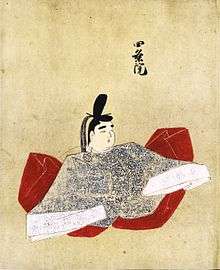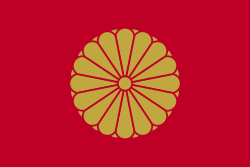Emperor Shijō
Emperor Shijō (四条天皇, Shijō-tennō) (March 17, 1231 – February 10, 1242) was the 87th emperor of Japan, according to the traditional order of succession. This reign spanned the years 1232 through 1242.[1]
| Shijō | |
|---|---|
 Shijō, Tenshi Sekkan Miei | |
| Emperor of Japan | |
| Reign | November 17, 1232 – February 10, 1242 |
| Coronation | January 16, 1233 |
| Predecessor | Go-Horikawa |
| Successor | Go-Saga |
| Born | March 17, 1231 |
| Died | February 10, 1242 (aged 10) |
| Burial | Tsukinawa no Misasagi (Kyoto) |
| Spouse | Kujō Genshi |
| House | Yamato |
| Father | Emperor Go-Horikawa |
| Mother | Fujiwara no Shunshi |
Genealogy
Before his ascension to the Chrysanthemum Throne, his personal name (his imina) was Mitsuhito-shinnō (秀仁親王),[2] also known as Tosihito-shinnō.[3]
He was the first son of Emperor Go-Horikawa.[4]
Consort: Kujō Genshi (九条 彦子; 1227–1262) later Nishinomon’in (宣仁門院), Kujō Norizane’s daughter
He had no children, due to his youth at the time of his death.
Events of Shijō's life
He reigned from October 26, 1232 to February 10, 1242.
- 1232 (Jōei 1, 11th month): In the 11th year of Emperor Go-Horikawa's reign (後堀河天皇十一年), he abdicated; and the succession (senso) was received by his oldest son. Shortly thereafter, Emperor Shijō is said to have acceded to the throne (sokui).[5]
Emperor Shijō died from an accident in 1242. His Imperial tomb (misasagi) is at Sennyū-ji in the Nochi no Tsukinowa no Higashiyama no misasagi (後月輪東山陵).[6]
As the Emperor was very young, and the Retired Emperor Go-Horikawa died just two years later, most of the actual leadership was held by his maternal relatives Kujō Michiie and Saionji Kintsune.
Kugyō
Kugyō (公卿) is a collective term for the very few most powerful men attached to the court of the Emperor of Japan in pre-Meiji eras. Even during those years in which the court's actual influence outside the palace walls was minimal, the hierarchic organization persisted.
In general, this elite group included only three to four men at a time. These were hereditary courtiers whose experience and background would have brought them to the pinnacle of a life's career. During Shijō's reign, this apex of the Daijō-kan included:
- Sesshō, Kujō Norizane, 1231–1232
- Sesshō, Kujō Norizane, 1232–1235
- Sesshō, Kujō Michiie, 1235–1237
- Sesshō, Konoe Kanetsune, 1237–1242
- Sadaijin
- Udaijin
- Nadaijin
- Dainagon
Eras of Shijō's reign
The years of Shijō's reign are more specifically identified by more than one era name or nengō.[7]
- Jōei (1232–1234)
- Tenpuku (1233–1234)
- Bunryaku (1234–1235)
- Katei (1235–1238)
- Ryakunin (1238–1239)
- En'ō (1239–1240)
- Ninji (1240–1243)
See also
- Emperor of Japan
- List of Emperors of Japan
- Imperial cult
Notes

- Titsingh, Isaac. (1834). Annales des empereurs du Japon, pp. 242–245; Varley, H. Paul. (1980). Jinnō Shōtōki. p. 227.
- Varley, p. 227.
- Titsingh, pp. 241–242.
- Titsingh, p. 242; Varley, p. 227.
- Titsingh, p. 241-242; Varley, p. 44; n.b., a distinct act of senso is unrecognized prior to Emperor Tenji; and all sovereigns except Jitō, Yōzei, Go-Toba, and Fushimi have senso and sokui in the same year until the reign of Emperor Go-Murakami.
- Sennyū-ji: official English web page; Archived 2008-09-16 at the Wayback Machine images of front of Imperial mausoleum enclosure.
- Titsingh, p. 242.
References
- Ponsonby-Fane, Richard Arthur Brabazon. (1959). The Imperial House of Japan. Kyoto: Ponsonby Memorial Society. OCLC 194887
- Titsingh, Isaac, ed. (1834). [Siyun-sai Rin-siyo/Hayashi Gahō, 1652], Nipon o daï itsi ran; ou, Annales des empereurs du Japon. Paris: Oriental Translation Fund of Great Britain and Ireland.
- Varley, H. Paul , ed. (1980). [ Kitabatake Chikafusa, 1359], Jinnō Shōtōki (A Chronicle of Gods and Sovereigns: Jinnō Shōtōki. New York: Columbia University Press. ISBN 0-231-04940-4
| Regnal titles | ||
|---|---|---|
| Preceded by Emperor Go-Horikawa |
Emperor of Japan: Shijō 1232–1242 |
Succeeded by Emperor Go-Saga |
